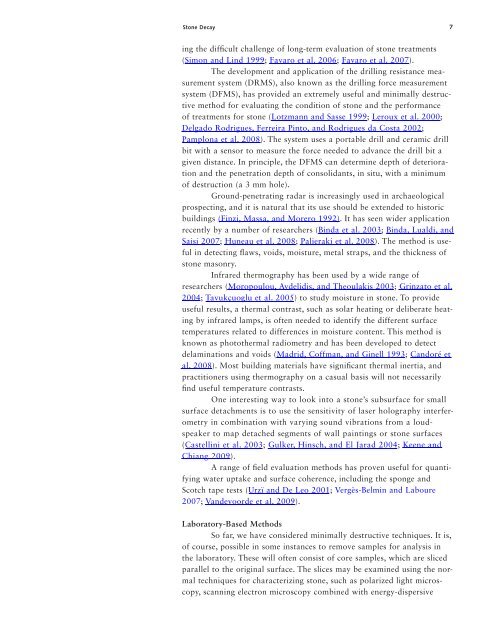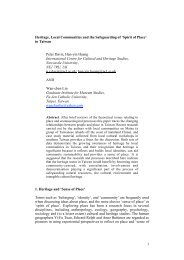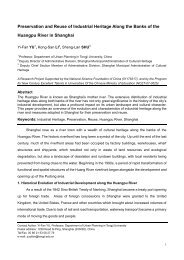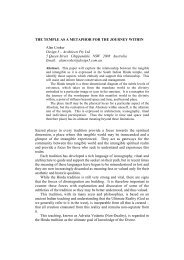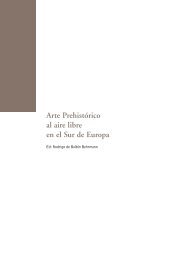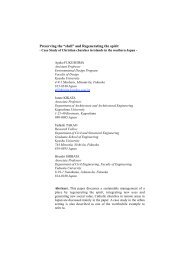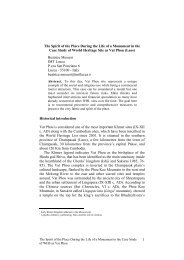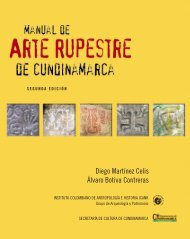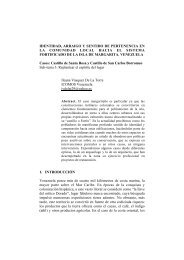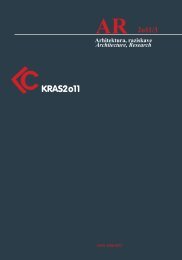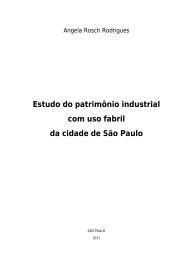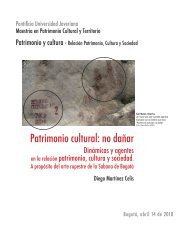<strong>Stone</strong> Decay 7ing the difficult challenge <strong>of</strong> long-term evaluation <strong>of</strong> stone treatments(Simon and Lind 1999; Favaro et al. 2006; Favaro et al. 2007).The development and application <strong>of</strong> the drilling resistance measurementsystem (DRMS), also known as the drilling force measurementsystem (DFMS), has provided an extremely useful and minimally destructivemethod for evaluating the condition <strong>of</strong> stone and the performance<strong>of</strong> treatments for stone (Lotzmann and Sasse 1999; Leroux et al. 2000;Delgado Rodrigues, Ferreira Pinto, and Rodrigues da Costa 2002;Pamplona et al. 2008). The system uses a portable drill and ceramic drillbit with a sensor to measure the force needed to advance the drill bit agiven distance. In principle, the DFMS can determine depth <strong>of</strong> deteriorationand the penetration depth <strong>of</strong> consolidants, in situ, with a minimum<strong>of</strong> destruction (a 3 mm hole).Ground-penetrating radar is increasingly used in archaeologicalprospecting, and it is natural that its use should be extended to historicbuildings (Finzi, Massa, and Morero 1992). It has seen wider applicationrecently by a number <strong>of</strong> researchers (Binda et al. 2003; Binda, Lualdi, andSaisi 2007; Huneau et al. 2008; Palieraki et al. 2008). The method is usefulin detecting flaws, voids, moisture, metal straps, and the thickness <strong>of</strong>stone masonry.Infrared thermography has been used by a wide range <strong>of</strong>researchers (Moropoulou, Avdelidis, and Theoulakis 2003; Grinzato et al.2004; Tavukçuoglu et al. 2005) to study moisture in stone. To provideuseful results, a thermal contrast, such as solar heating or deliberate heatingby infrared lamps, is <strong>of</strong>ten needed to identify the different surfacetemperatures related to differences in moisture content. This method isknown as photothermal radiometry and has been developed to detectdelaminations and voids (Madrid, C<strong>of</strong>fman, and Ginell 1993; Candoré etal. 2008). Most building materials have significant thermal inertia, andpractitioners using thermography on a casual basis will not necessarilyfind useful temperature contrasts.One interesting way to look into a stone’s subsurface for smallsurface detachments is to use the sensitivity <strong>of</strong> laser holography interferometryin combination with varying sound vibrations from a loudspeakerto map detached segments <strong>of</strong> wall paintings or stone surfaces(Castellini et al. 2003; Gulker, Hinsch, and El Jarad 2004; Keene andChiang 2009).A range <strong>of</strong> field evaluation methods has proven useful for quantifyingwater uptake and surface coherence, including the sponge andScotch tape tests (Urzï and De Leo 2001; Vergès-Belmin and Laboure2007; Vandevoorde et al. 2009).Laboratory-Based MethodsSo far, we have considered minimally destructive techniques. It is,<strong>of</strong> course, possible in some instances to remove samples for analysis inthe laboratory. These will <strong>of</strong>ten consist <strong>of</strong> core samples, which are slicedparallel to the original surface. The slices may be examined using the normaltechniques for characterizing stone, such as polarized light microscopy,scanning electron microscopy combined with energy- dispersive
8 Chapter 1spectroscopy, hygric tests, and biaxial flexural strength measurements(Mamillan 1991; Snethlage, Wendler, and Sattler 1991; Bläuer Böhm2004). Surface hardness measurements may be useful, and the salt content<strong>of</strong> the slices may also be determined (Bläuer Böhm 2005).The European Commission (EC) projects COMPASS andDESALINATION have developed a simple test for salt content basedon the hygroscopic moisture content (HMC) (Gonçalves and DelgadoRodrigues 2006; Gonçalves, Delgado Rodrigues, and Abreu 2006;Nasraoui, Nowik, and Lubelli 2009). Kaminski (2008) has proposed analternative gravimetric system and makes some constructive criticisms<strong>of</strong> common aspects <strong>of</strong> the diagnosis and analysis <strong>of</strong> moisture and salts,including misleading readings from moisture meters based on electricalresistance or dialetric properties, dry drill powders showing lower thanexpected results, and salt solution–conditioned chambers not providingconsistent conditions for HMC measurements.Jacobs, Sevens, and Kunnen (1995) proposed the use <strong>of</strong> computerizedX-ray tomography (CT) to gain further insight into the internalstructure <strong>of</strong> stone and the changes that occur during the deterioration <strong>of</strong>building materials. Procedures were developed to bring the resolutiondown to grain-size level (about 100 microns or less). Mossotti andCastanier (1990) used CT scanning to show that for Salem limestone,capillary water reached the surface except under windy conditions, whenthe air/water interface moved into the stone. In the past decade, resolution<strong>of</strong> the CT method has advanced significantly (Bugani et al. 2008;Cnudde et al. 2009; Ruiz de Argandoña et al. 2009); however, it is stilldifficult to see treatments and salts inside pores owing to the lack <strong>of</strong>contrast and the small amount <strong>of</strong> material scanned. A promising way toovercome the limitations <strong>of</strong> x-ray CT is the use <strong>of</strong> high-speed neutrontomography (synchrotron radiation) for in situ dynamic analysis <strong>of</strong> wetting/drying,moisture transport, salt development, or the curing and evaluation<strong>of</strong> protective coatings and consolidants within a porous stone(Vlassenbroeck et al. 2007; Cnudde et al. 2008).The linear variable differential transformer (LVDT; also knownas a linear velocity displacement transducer) has also proven to be animportant lab tool in the quantitative evaluation <strong>of</strong> the thermal andhygric response <strong>of</strong> building materials to wetting and humidity cycles,measuring expansion and contraction behavior on a micron scale(Martin, Röller, and Stöckhert 1999; Lombardo, Doehne, and Simon2004; Poupeleer et al. 2006).Nuclear magnetic resonance (NMR) imaging (also known asMRI) <strong>of</strong> building materials has advanced rapidly in the last fifteen years.This method allows the measurement <strong>of</strong> hydrogen and sodium ions insolutions present inside porous materials and has provided an importantnew dimension for understanding the behavior <strong>of</strong> moisture in buildingmaterials, especially at the millimeter to centimeter scale (Pel, Kopinga,and Brocken 1996; Pel, Huinink, and Kopinga 2002; Rijniers et al. 2004;Huinink et al. 2006; Gonçalves, Pel, and Delgado Rodrigues 2009). Forexample, when a stone has finer pores than an overlying plaster, NMR
- Page 2 and 3: esearch in conservationThe Getty Co
- Page 4 and 5: Contentsvi Foreword to the Second E
- Page 6 and 7: ContentsvChapter 7 75 What Has Chan
- Page 8 and 9: Foreword to the Second Edition, 201
- Page 10: Preface to the Second Edition, 2010
- Page 13 and 14: Chapter Preface to # the First Edit
- Page 15 and 16: IntroductionAfter presenting his wo
- Page 18 and 19: Stone Decay 3ize terminology (Stone
- Page 20 and 21: Stone Decay 5.hpl.hp.com/news/2004/
- Page 24 and 25: Stone Decay 9has shown that if both
- Page 26 and 27: Stone Decay 11Damage to stone by ai
- Page 28 and 29: Stone Decay 13Some intriguing findi
- Page 30 and 31: Stone Decay 15crossing the deliques
- Page 32 and 33: Stone Decay 17pick up moisture from
- Page 34 and 35: Stone Decay 19by differences in the
- Page 36 and 37: Stone Decay 21Biological growths on
- Page 38 and 39: Stone Decay 23have appeared determi
- Page 40 and 41: Stone Decay 25Organic material in p
- Page 42 and 43: Chapter 2Putting It Right: Preventi
- Page 44 and 45: Stone Putting Decay It Right: Preve
- Page 46 and 47: Stone Putting Decay It Right: Preve
- Page 48 and 49: Stone Putting Decay It Right: Preve
- Page 50 and 51: Stone Putting Decay It Right: Preve
- Page 52 and 53: Stone Putting Decay It Right: Preve
- Page 54 and 55: Stone Putting Decay It Right: Preve
- Page 56 and 57: Stone Putting Decay It Right: Preve
- Page 58 and 59: Stone Putting Decay It Right: Preve
- Page 60 and 61: Stone Putting Decay It Right: Preve
- Page 62 and 63: Stone Putting Decay It Right: Preve
- Page 64 and 65: Chapter 3Do They Work? Assessing th
- Page 66 and 67: Stone Do They Decay Work? Assessing
- Page 68 and 69: Stone Do They Decay Work? Assessing
- Page 70 and 71: Stone Putting Decay It into Practic
- Page 72 and 73:
Stone Putting Decay It into Practic
- Page 74 and 75:
Stone Heritage Decay in Stone: Rock
- Page 76 and 77:
Stone Heritage Decay in Stone: Rock
- Page 78 and 79:
Stone Heritage Decay in Stone: Rock
- Page 80 and 81:
Stone Heritage Decay in Stone: Rock
- Page 82 and 83:
Stone Doing Decay Better: Increasin
- Page 84 and 85:
Stone Doing Decay Better: Increasin
- Page 86 and 87:
Stone Doing Decay Better: Increasin
- Page 88 and 89:
Stone Doing Decay Better: Increasin
- Page 90 and 91:
Chapter # 7Chapter What Has Title C
- Page 92 and 93:
Stone What Has Decay Changed? Some
- Page 94 and 95:
Stone What Has Decay Changed? Some
- Page 96 and 97:
Chapter References #Chapter TitleAu
- Page 98 and 99:
References 83ed. D. Decrouez, J. Ch
- Page 100 and 101:
References 85Balboni, E., R. M. Esp
- Page 102 and 103:
References 87Bläuer, C., and A. Ku
- Page 104 and 105:
References 89carried out on Lecce s
- Page 106 and 107:
References 91Charola, A. E. 1995. W
- Page 108 and 109:
References 93Davis, K. J., and A. L
- Page 110 and 111:
References 95Doehne, E., and S. Pin
- Page 112 and 113:
References 97Facaoaru, I., and C. L
- Page 114 and 115:
References 99Buildings and Monument
- Page 116 and 117:
References 101Historia. http://www.
- Page 118 and 119:
References 103Poland, ed. J. W. Luk
- Page 120 and 121:
References 105the International RIL
- Page 122 and 123:
References 107Jurado, V., A. Fernan
- Page 124 and 125:
References 109Kumar, N., U. C. Kuls
- Page 126 and 127:
References 111“Conservation of St
- Page 128 and 129:
References 113Maravelaki-Kalaitzaki
- Page 130 and 131:
References 115Meinhardt-Degen, J.,
- Page 132 and 133:
References 117Mosch, S., and S. Sie
- Page 134 and 135:
References 119Paradise, T. R. 2002.
- Page 136 and 137:
References 121of porous stones: A u
- Page 138 and 139:
References 123Rodríguez-Navarro, C
- Page 140 and 141:
References 125Sawdy, A., A. Heritag
- Page 142 and 143:
References 127Siedel, H. 2008. Salt
- Page 144 and 145:
References 129Snethlage, R. 2005. L
- Page 146 and 147:
References 131the responsible and e
- Page 148 and 149:
References 133Vallet, J.-M., C. Gos
- Page 150 and 151:
References 135Viles, H. A., D. Camu
- Page 152 and 153:
References 137Whitley, D. S. 2005.
- Page 154 and 155:
References 139Zezza, F. 1990. Compu
- Page 156 and 157:
Appendix: Resources for Stone Conse
- Page 158 and 159:
Appendix: Resources for Stone Conse
- Page 160 and 161:
Appendix: Resources for Stone Conse
- Page 162 and 163:
Appendix: Resources for Stone Conse
- Page 164 and 165:
Appendix: Resources for Stone Conse
- Page 166 and 167:
Appendix: Resources for Stone Conse
- Page 168 and 169:
Index 153calcium hydroxide (slaked
- Page 170 and 171:
Index 155hexafluoropropene-vinylide
- Page 172 and 173:
Index 157research needed on, 55-56w
- Page 174 and 175:
About the AuthorsEric Doehne holds


